If you have ever heard of Tantra Yoga, it might be tempting to assume that it is related to tantric sex (a spiritual form of sex), but it is not. However, tantric yoga is deeply connected to pleasure, and being in tune with your body. A modern take on the ancient Vedic and spiritual practices, this style of yoga is a creative and unconventional way of experiencing oneness with your true Self and the entire cosmos.
The Tantrics are techniques that were ironed out on the foundation of using the body as a tool to explore pleasure and meditation.
In this article, we’ll discuss everything you need to know about Tantra Yoga.
What is Tantra Yoga?
Tantric Yoga is a yoga practice surrounding the concept of tantra, an ancient practice that began in India, Tibet, and various parts of Asia. When the Sanskrit word Tantra was first used in yogic texts, it meant to “weave or loom.” Over time, the word tantra evolved into meaning “technique, device, or method.”
The most recent and relevant definition of Tantra coming from the Kāmikā-tantra text relays that tantra means: “Because it elaborates (tan) copious and profound matters, especially relating to the principles of reality (tattva) and sacred mantras, and because it provides liberation (tra), it is called a tantra.”
That being said, Tantra Yoga is a style of yoga that weaves together a variety of techniques including mantra meditation, visualization, mudras, pranayama, and initiation to study the inner-universe through our human body. The main purpose of Tantra Yoga is to cultivate kundalini energy so that it can flow throughout the body, travel upwards toward the crown chakra and then spill out from the top, creating enlightenment.
According to Hindu beliefs, kundalini is a form of divine feminine energy that is located at the base of the spine. We are all born with kundalini, which represents creativity, female deity, and is the ultimate life-force energy. Tantric techniques aim to unlock this energy center and uncoil the snake.
Where other styles of yoga might encourage you to turn your awareness outwards, Tantra focuses on the physical body and the cultivation of your own energy. Tantric practice is essentially a moving meditation that allows us to attain spiritual growth using our own body.
Tantra Yoga techniques
The worship of Shiva and Shakti, the dynamic and static principles of the universe, lay the groundwork for the teachings and focus of Tantra Yoga. Shakti is dynamic, creative, and feminine energy whereas Shiva is static, destructive, and masculine. These energies are constantly manifesting in a gazillion different ways. Tantra Yoga seeks to create a bridge from our physical bodies to the Divine. Kundalini energy is activated through the practices of asana, pranayama, mudra, and shatkarma using the physical body as the primary tool.
Many of the yoga poses (asana) and breathing exercises (pranayama) that you’ll see in Hatha Yoga were derived from tantric yogis. Mudras consist of hand gestures and a powerful combination of asana, pranayama, and bandha (bind or energy lock). Shatkarma, also known as kriya, are esoteric exercises and techniques used to cleanse and purify the body’s energy pathways.
Mantra, yantra, and puja are the devotional practices used to develop the spiritual body. A mantra is a sacred Sanskrit sound that is said to be a manifestation of divine power. A yantra is a sacred geometric form used for concentration and visualization during Tantric rituals. Puja is the active worship of a selected deity through offerings of food, incense, light, water and gems.
How to practice Tantra Yoga
Now that you have an idea of the sensual, delightful practice of Tantra Yoga, here are some tips for how you can practice it:
- Silence the chatter in your mind: Before practicing, notice the thoughts that are bouncing around in your mind. Are your thoughts negative? Self-destructive? Tantric yoga is centered around silencing the mental chatter that is holding you back so that you have the ability to flow through the asanas with ease. Tantra Yoga is all about attaining self-realization and personal empowerment. Once you learn to trust yourself, you will be closer to reaching this goal.
- Become comfortable with silence: Traditional Tantra Yoga classes are not practiced with music. This could be uncomfortable at first, but tantric yogis believe in the power of silence.
- Let go of making flexibility and physical fitness your end goal: It’s natural for us to desire these things, but it’s more productive to allow these things to unfold naturally as we become more intimately aware of our mind and body.
- Open yourself up to receive pleasure: Tantra is all about experiencing pleasure. Keep in mind that we aren’t necessarily talking about sexual pleasure. While there are tantric yoga postures to help couples have better sex, Tantra Yoga is all about experiencing a feeling of blissful sensation in your body. According to tantric principles, the things we do in everyday life should bring you pleasure.
- Follow your own path: Tantra Yoga principles will unravel the conditioning we have grown accustomed to our whole life. Western culture has taught us to fall in line and live up to certain standards in order to fit in and be happy. Tantra Yoga encourages us to be empowered and follow the beat of our own drum.
Frequently Asked Questions (FAQs)
Here are some of the most common questions that people have about Tantra Yoga.
What is the goal of tantric yoga?
The goal of Tantra Yoga is to experience pleasure in your own body, grow spiritually, and learn how to experience eternal bliss through the cultivation of kundalini energy.
What is Tantra yoga and its benefits?
Tantra Yoga is a form of yoga that uses a variety of techniques primarily focused on the cultivation of kundalini energy to help us reach a state of eternal bliss. Tantra yoga will help you break free of any negative conditioning you have learned, allow you to build trust in yourself, and reach a state of self-realization.
What is the difference between yoga and Tantra?
Yoga is typically a broad term for different types of yoga, whereas Tantra is a Sanskrit word that means “weave.” Tantra Yoga is a form of yoga that is focused on pleasure and using the physical body as a tool to empower us and improve our spiritual growth.







